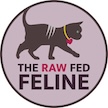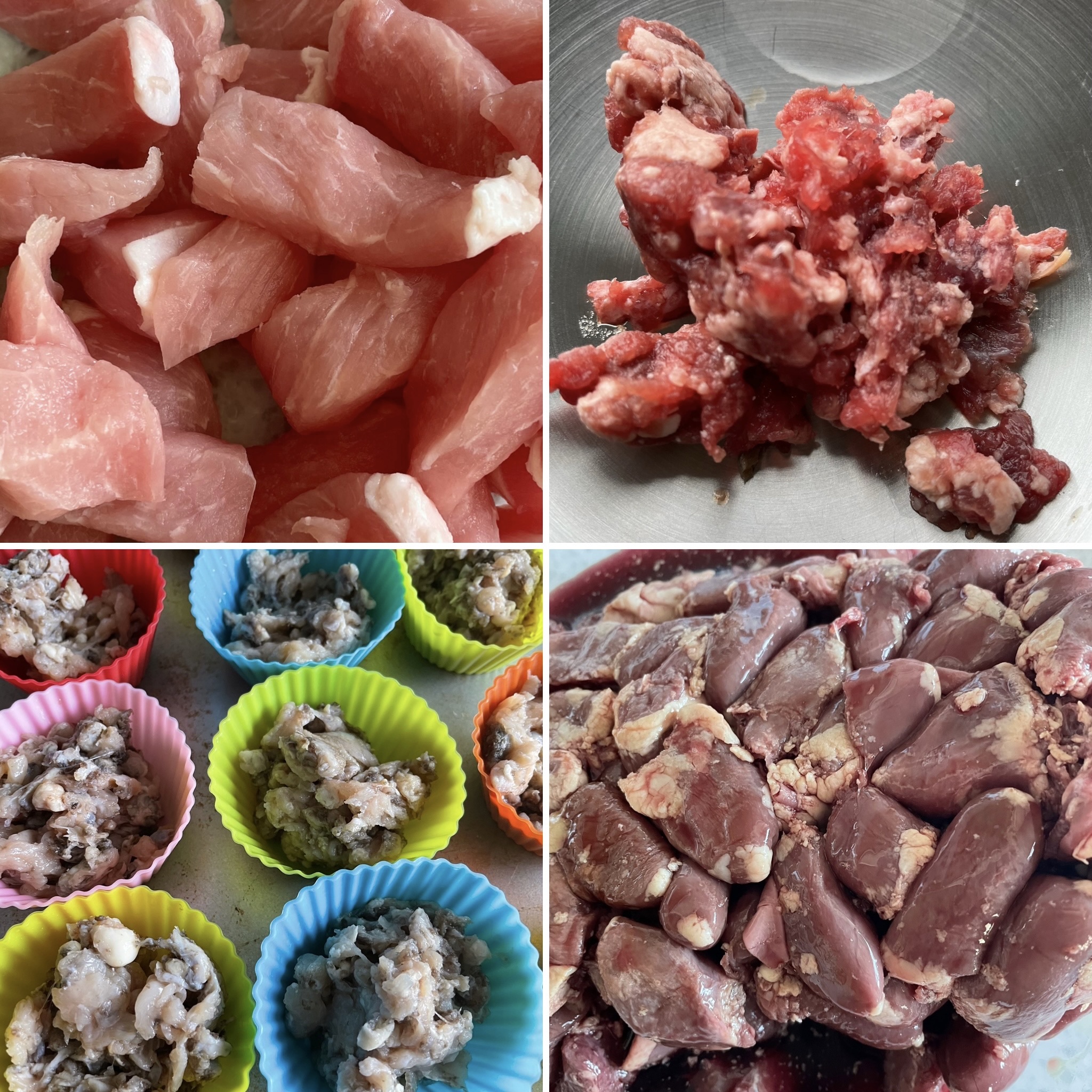I am going to talk about the base of the PMR Food Pyramid for Felines: meat and muscular organs. There’s lots to cover, so let’s get right to it.

The ratio of meat used for cats is 84% when using bone in the diet and 90% when using ground eggshell. The ratio looks like this: 84/6/5/5 or 90/5/5. We will assume that we are using bone in this example. Of this 84% meat, up to 20% can be made of muscular organs. Let’s take a look at the different meats you can offer your cat, what exactly are muscular organs, and where to find them. But first, you need to know how much meat your cat needs.
How much meat
You need your cat’s weight to figure out how much meat is needed for your cat. I talked about how to do this here. For this post, we’ll use this example: say you have a 10 lb adult cat who is moderately active—you would first change the weight in pounds to weight in ounces, so 10 X 16 (because there are 16oz in a pound)=160oz. Starting with 3% to feed (this is a common starting point for adult cats), you would take 160 X 3%=4.8oz per day of raw food is needed for this cat. You can decide if you want to make food daily, weekly, or monthly, that is just personal preference.
In this example, we will figure out amounts for a week. We can do this by taking 4.8oz X 7 days=33.6oz of total food per week. You can round up to 34oz for ease.
Now we’ll determine the amount of meat needed for the week:
34oz X 84%=28.56oz of meat
Of this 28.5oz of meat, up to 20% can be muscular organs, so we will take 28.5oz X 20%=5.7oz. So, 22.8oz can be meat and 5.7oz can be muscular organs (28.5-5.7=22.8). Again, you can round these amounts in ways that make sense, so in this example, I would use 23oz of meat and 5.5oz of muscular organs. With me so far? I hope so.
notes
I used Imperial units of measure rather than metric, but the formula is the same. You would just use kg and grams rather than pounds and ounces.
While this math part might be overwhelming at first, remember that if you have an adult cat that is maintaining weight, you don’t have to recalculate these numbers all of the time. Once you have them figured out and your cat is doing well with that amount of food, you’re all set.
Which meats are good to feed?
Ok, now that we know how much meat to include in our weekly batch of food for our example cat, which meats are good to feed?
You want to include a variety of red and white and fat and lean meats in rotation. Some examples of meat that can be fed: chicken, turkey, beef, pork, venison, bison, emu, duck, elk, pheasant, quail, rabbit, lamb, goat, kangaroo, and any other meats your cat might like or that are available to you.
The meats you do not want to feed are other carnivores due to issues with biomagnification, fish should not be used as a main protein, and wild boar, walrus, and bear should not be fed raw. Any wild game should be frozen for at least three weeks prior to feeding raw to kill any potential parasites. The meat should not have any additives or flavorings and the sodium content should be less than 100mg per serving.
Meat is the base of our little carnivores’ diet. It provides the all important protein our cats need as well as fat with no measurable carbohydrates. All of the meats listed below provide both protein and fat in different amounts. I will group them by whether they are classified as red or white meat. You want to feed at minimum 50% red meats in your raw fed feline’s diet.
red meats
pork and its image issues
Pork is a favorite meat of many cats, and surprisingly to many, it is considered a red meat. Poor maligned pork! There are continued outdated concerns about feeding this particular meat more than any others. Human grade, farmed pork is a fantastic option to include in your cat’s diet. It is easy to source and one of the most affordable meats to feed. Pork is a good source of thiamin, riboflavin, niacin, vitamin B6, and selenium.
One concern that people have is that pork is too fatty, but that is related to which cut of meat you choose. Both pork tenderloin and boneless chops are nice and lean.

Another common concern include parasites. Trichinella is one of those outdated concerns, as it has been eradicated in the US, Canada, and parts of the EU for many years. (However, if you live in a country without regulations regarding the husbandry practices re: pigs, then you would want to take extra precautions and be sure to freeze pork before feeding raw.)
Pseudorabies is another concern, but this is very easy to avoid. Just don’t feed wild boar, only farmed. Wild boar should never be fed raw due to the potential of pseudorabies as this is a freeze resistant virus.
other red meats
Beef and bison are wonderful red meats to feed. Bison, while similar to beef, has some important differences. Bison is lower in calories and fat, and has slightly more protein than beef. They have comparable amounts of iron, zinc, phosphorus, selenium, and B vitamins. One of the most significant differences is how they are raised. Bison is almost always grass fed and pasture raised as opposed to beef cattle, which are often grain fed on feed lots. Since bison are grass fed, they offer omega-3s.
Kangaroo is extremely lean and is a great source of iron, zinc, and omega-3s. Kangaroo meat has twice the amount of iron as compared to beef, and three times as much as chicken and pork!
Lamb is a higher fat meat, and a good source of zinc and iron.
Venison is a nice lean meat. It is a good source of potassium, zinc, and B vitamins. Bonus-venison can often be sourced from local hunters, too.
Goat is a very lean red meat. It is high in iron and a good source of B12 and selenium.
Duck is higher in fat, and is a good source of iron and selenium.
Elk is an awesome lean red meat. It is a great source of zinc and B12.
Any wild game, including wild caught rabbit, is considered a red meat. Wild game tends to be very lean. Muskrat, beaver, and moose are some game options that might be available to you.

white meats
Now on to the white meats. These are comprised of chicken, Cornish hen, turkey, quail, as well as farmed rabbit.
Chicken is typically one of the easiest meats to source and afford. Thigh meat has a better nutritional profile than breast meat and is preferred. Thigh meat is a good source of riboflavin, niacin, and B6. Chicken in general is higher in omega-6s, so it’s important to include some omega-3 in the diet for balance.
As with chicken, turkey thigh meat is a better choice than breast meat. Turkey is lower in fat and a good source of several B vitamins and selenium. You have to really pay attention to turkey in the US. This is a meat that often has “natural flavorings” included.
Quail is leaner than chicken, and is a nice source of iron.
Rabbit tends to be well loved by most cats. Rabbit is very lean and notably lower in taurine than other meats. It is a good source of niacin, B12, and B6.
Muscular organs
Muscular organs are organs that are made of muscle. This is in contrast to secreting organs, which synthesize substances that are released in the body. Muscular organs include hearts, tongue, lungs, gizzards, tripe, and uterus. These can be included up to 20% of the total amount of meat.
Hearts are an especially important source of taurine and should be included regularly in the diet. Chicken, duck, turkey, beef, pork, and lamb hearts are possible options, but keep in mind that the smaller the heart, the more taurine it will have. Tongue is also a great source of taurine. I wrote about taurine and its sources here.

Tripe is stinky stuff, like, really stinky. It is a good source of manganese, an essential micro mineral, as well as enzymes and beneficial bacteria. Tripe only comes from ruminant animals. It is specifically the stomach lining of the 4th stomach. The 4th stomach is where enzymes and bacteria are released to break down hard to digest plant matter.
The nutrients, enzymes, and bacteria of tripe are great to feed, but you want to be sure to get raw green tripe, which in the US, can only be sold by pet food suppliers. Tripe sold for human consumption has been bleached, so there is no nutritional value left.

Where to source meat & muscular organs
There are several options from where to source your meat and muscular organs. Meat for human consumption in North America, most countries in the EU, and others that have regulatory agencies in place that provide inspection are safe to feed. Meat designated for human consumption in the US has much more regulatory oversight regarding overall sanitation and safety, including the processing, handling, and transport of the meat.
This means that any meat sold for human consumption, such as at any grocery stores, butchers, meat markets, and Asian markets are great places to find meat for your cat’s diet. Asian markets are especially great places to find duck and chicken hearts.
Raw pet food suppliers sell common meats and sometimes have more exotic offerings available, too, such as camel, kangaroo, ostrich, and pheasant! As I mentioned above, raw green tripe can only be purchased from pet food suppliers.
You may also want to check if there is a raw feeding co-op near you. They are member groups who purchase meats directly from suppliers in bulk, so they can get really great pricing. You can often find them on FaceBook.
Feed a variety of meats & muscular organs in rotation
There you have it! It can be a really fun part of raw feeding to offer different meats and muscular organs in your cat’s rotation. Let me know if you have any questions in the comments below.
Next up, I’ll tackle the topic of bones and bone substitutes as we make our way up the pyramid.


